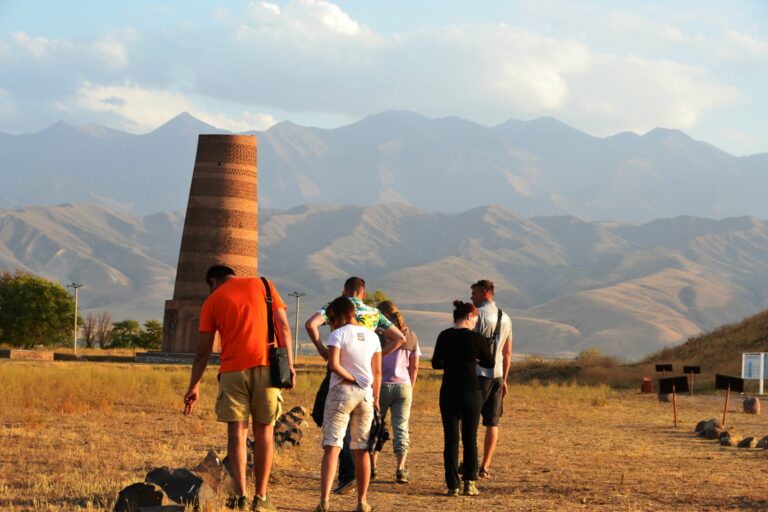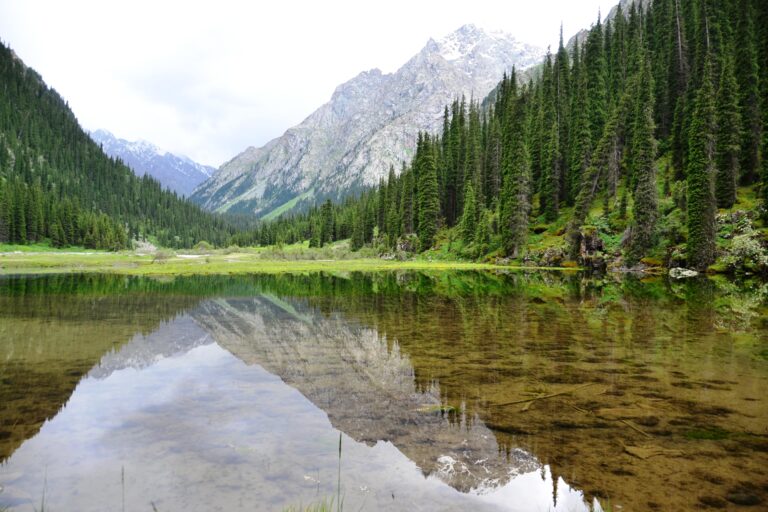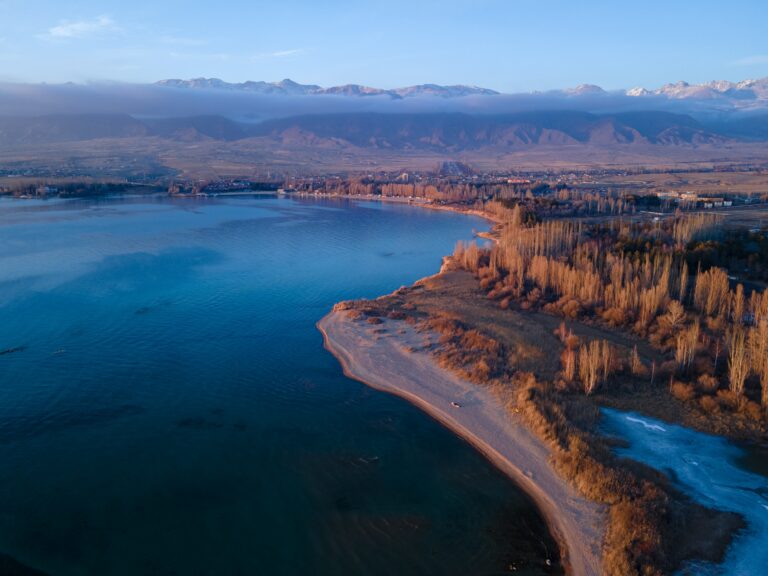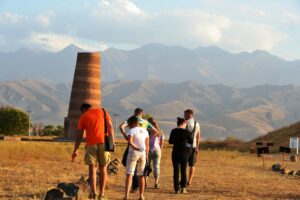History of Tower
Burana tower. 12 km south-west of Tokmok is the site of the medieval settlement of Balasagun, the capital of the Karakhanid Kaganate.
The Karakhanid Kaganate in the X-XII centuries was the largest feudal state in Central Asia and Kazakhstan. Its founders, “karakhans” (natives of the Chitil tribe), who lived in the Tien Shan, in a short time in the second half of the 10th century conquered a vast territory, which included the lands from the Ili River in the east to the Amu Darya River in the west. So one of the capitals of this state was the city of Balasagun. Middle of X century, founded by Karahanids. In the eastern part of the Chu Valley.
In the territory of Kyrgyzstan, under the Karakhanids, old cities and settlements developed and new ones appeared. The centers of large cities were improved. Consequently muslim religious buildings were erected. In the territory of Kyrgyzstan, the Karakhanids developed old cities. New settlements emerged. And the centers of large cities were developed. As a result, burana tower built in the first half of the Xl century.
In 1218 Balasagun surrendered without a fight to the advanced detachments of the untold Mongol invasion.
The city continued to exist in the XIII-XlV centuries, but was no longer as important as before. However, life in the city gradually faded. The inhabitants leave it. The buildings destroyed in the XV century.
In 1927-1928, repairs and conservation carried out.
Burana mound has a complex layout and consists of the central ruins and a large area outside of it. This territory was the main part of the city. There were residential and household constructions of citizens, their land allotments, numerous craft workshops, bazaars, etc. Double ring of fortress walls protected this territory. Thus, the length of the outer wall on the circle reached 15 km. And the area of the city was 25-30 sq. km.
In 1970-1974 the Burana Tower restored. By the decision of Council of Ministers in 1976, on the basis of Burana settlement the Republican archeological-architectural open-air museum created.
The territory of the museum consists of the central ruins of the settlement with an area of 36 hectares. The ancient ramparts surrounding this territory are quadrangular in plan, the sides of which oriented along the sides of the world. The dimensions of the quadrangle are 570×600 m. The preserved height of the ramparts is 3-4 m, while the original height reached 8-10 m. On the east side of the central ruins is a hill 100×100 m. in size and 10 m. high which presumably hides the remains of a palace complex or temple which existed here before the 10th century, i.e. before the foundation of the city.
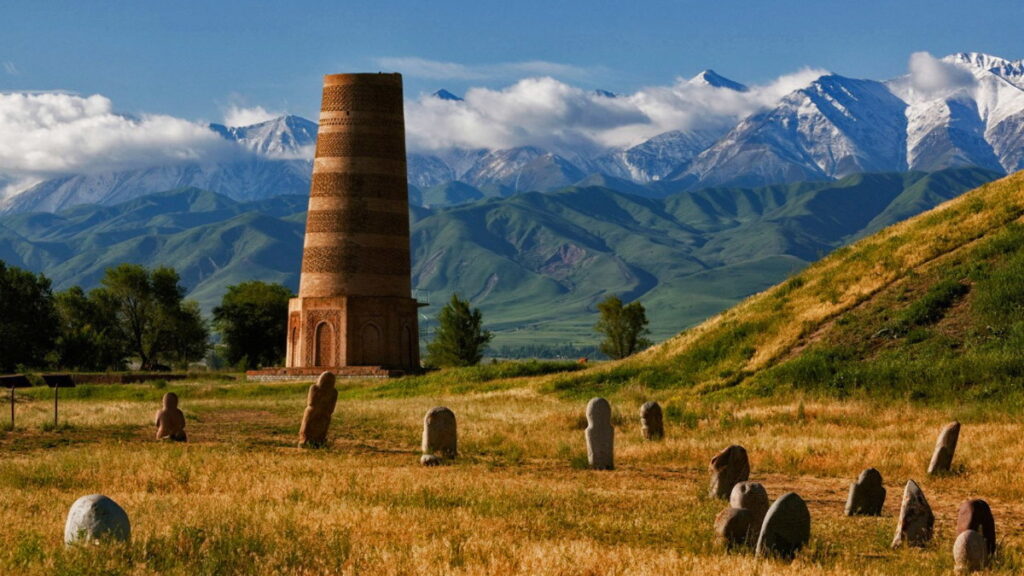
Construction of Burana Tower
Above all, Burana tower is a minaret of XI century and is one of the first constructions of such type on the territory of Central Asia. Minarets built at mosques because it served to call the faithful to prayer. It assumed that the mosque near the Burana Tower was located on its western side.
In addition, the original height of the Burana minaret was 45 m. As with all minarets, its top topped by a dome-lantern with four door apertures on each side of the world. In a strong earthquake around the 15th century it collapsed. So, now the height of the tower is 24.6 m
Burana Tower has three parts:
The podium or stylobate, the octagonal plinth and the trunk.
All this construction rests on a foundation sunk 5 meters into the ground. The trunk of the minaret has a conic shape with a diameter of 9,3 m at the bottom and tapering down to 6 m at the top. So, the surface of the trunk consists of alternating smooth and relief masonry belts. As a result, give it an openwork look. On the southern side at a height of 6.45 m there is an entrance to the minaret. From the entrance to the top of the minaret inside its trunk in counter-clockwise direction there is a spiral staircase with steps from burnt brick. The top of the steps covered with planks. On the eastern side of the minaret were mausoleums (kumbezi), the remains of which were excavated in 1970-1974. But, only the lower bases remained of them.
After the restoration of the minaret in 1984, a spiral staircase was added to the entrance.
All three mausoleums are unique monuments of medieval architecture in Kyrgyzstan.
The museum also displays exhibits, both those found in the settlement and those brought from other parts of the republic.
The exhibits are stone statues – gravestones of nomadic Turks of Vl-X centuries, petroglyphs of II millenium B.C., rock paintings of XIII millenium A.D. – X century A.D., stone farming tools, epigraphic monuments, etc.
The town of Balasagun was a hometown to Khas Khadzhib Yusuf Balasagunsky, an outstanding poet and thinker of the Middle Ages. He is the author of the famous poem “Kutadgu bilit” (“graceful knowledge” or “Science of government”), written in 1069.

